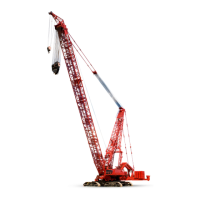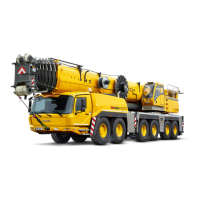Manitowoc Published 10-01-2012, Control # 045-08 1-39
777 SERVICE MANUAL INTRODUCTION
1
TRAVEL SYSTEM
See Figures 1-25 and 1-26 for following procedures.
When travel park brake switch, located on the front console
in the operator’s cab, is placed in the on position, the control
opens the travel command input circuit to the PC and does
not energize travel brake hydraulic solenoid HS1. Travel
park brakes remain applied and travel pumps do not stroke in
response to commands from right and left crawler control
handles.
When travel park brake switch is placed in the off position,
the travel command input voltage circuit to the PC is
completed. After receiving the voltage signal, the PC
prepares the crane’s travel system for activation.
Off
When crawler control handles are in the off position, the PC
circuits are open to the right and left travel pump EDCs and
travel brake hydraulic solenoid HS1. Travel pumps do not
stroke and travel park brakes remain spring-applied to hold
the crane in position.
Left Crawler Forward
NOTE: Electric current to the EDCs and the hydraulic oil
flow to the motor are opposite for reverse travel.
When left crawler control handle is moved in the forward
direction, the PC closes a regulated reverse polarities
voltage (0 to 2.7 volts) circuit to the left travel pump EDC and
completes a circuit to HS1 through travel park brake switch.
Travel park brake valve shifts to release travel park brakes
with charge pressure from rear hoist pump before left travel
pump strokes.
The EDC tilts the swashplate of left travel pump in the
forward direction, and the pump strokes on. Oil flows from
port A of pump through the swivel to port B of left travel
motor. The PC controls voltage to the left travel pump EDC,
governing travel speed in response to movement of left
crawler control handle. If right crawler control handle is
moved in the forward direction, oil flows from port B of right
travel pump to port A of right travel motor.
The travel motors are variable displacement in configuration
and shift internally via an adjustable spring in each of the
motors’ pressure compensator regulator (PCR) valves
preset at 3,915 psi (270 bar). With the system pressure
below the compensator setting and high speed travel switch
open (high speed position), the travel motor is maintained in
the minimum displacement position. When the system
pressure exceeds the PCR setting, the pressure causes the
servo mechanism to tilt the cylinder block, increasing motor
displacement and output torque and decreasing the motor
speed. When the crawler begins to move, the motor PCR
valve shifts the motor into the maximum displacement
position (low speed high torque) required for breakaway
torque, then gradually returns to minimum displacement
output when the crawler is moving with less effort.
The travel motor may be externally shifted into the maximum
displacement position (low speed) during periods when
precise controllability over the load is required. The motor
shifts when high speed travel switch is closed (low speed
position), completing an input circuit to the PC. The PC
energizes travel speed hydraulic solenoid HS13 and 2-
speed travel valve shifts, directing pressure from the rear
hoist charge pump to externally shift the travel motor to
maximum displacement and remain in this position until high
speed travel switch is opened.
FIGURE 1-25

